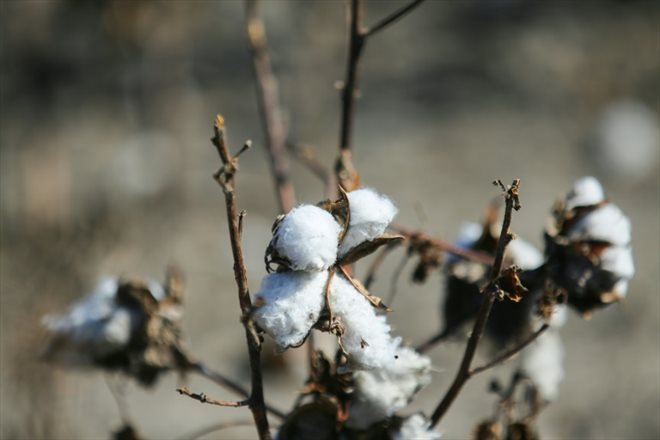Cotton harvested in a field near Waxahatchie, Texas on September 19, 2022 (AFP/Andy JACOBSOHN)
Of its ravaged cotton fields, there is almost nothing left, 20% to be saved, perhaps. The drought affecting part of the United States destroyed most of the production of Sutton Page, a farmer in Texas.
This year, his harvest “is not at its best”, he says with the restraint of a man who has seen others. The reality is that of a disaster: in his region in the north of the state, he assures AFP by telephone, almost all of his colleagues will not even harvest their cotton, leaving all of their “bare, bare” fields.
Texas produces nearly half of American cotton, with the United States being the world’s third largest supplier behind India and China. This year, national production will hit its lowest level since 2015, down 21% year-on-year, and Texas will suffer a 58% drop, according to the latest estimates from the US Department of Agriculture.
In the northwest of the state, where “cotton is king” and water scarce, the 2022 harvest “could be one of the worst in 30 years”, worries Darren Hudson, professor of agricultural economics at Texas Tech University. With the cascading consequences on the rest of the textile industry, in August he assessed the economic losses for the region at two billion dollars.

Farmer Steve Patman holds cotton in his hand in his field near Waxahatchie, Texas on September 19, 2022 (AFP/Andy JACOBSOHN)
Landon Orman, 30, works on 2,000 acres near Abilene, three hours west of Dallas. His non-irrigated cotton “didn’t even germinate”, the partially watered one grew but should have a yield reduced by half. In total, he judges, a plunge of 85% compared to the production of a usual year.
Like so many others, he has crop insurance, so “financially, it’s fine. But as a farmer, it really annoys us not to be able to grow our plants, that’s what I like”, says he.
– Depressing –
In Lubbock, the local cotton capital, rainfall for the past 12 months – before rains that arrived too late in August – was half of normal.
“From January to May, we had literally no rain,” said Sutton Page, 48. Minimal rains during the winter and spring left very dry soil at planting time.

Cotton harvested in a field near Waxahatchie, Texas on September 19, 2022 (AFP/Andy JACOBSOHN)
“And from May, we saw days arrive at over 37°C and winds at 50 km / h, and it fried everything,” he recalls. Texas experienced its second hottest summer on record.
At home, no irrigation possible, he had to plow four-fifths of his cotton fields, annihilated, to prevent them from drying out.
Of its remaining 20%, Sutton Page describes “low plants”, small fruits, less cotton. “We are looking at whether it is economically profitable to carry out the harvest, or if we simply have to destroy it.”
“It’s a bit depressing, you work hard all year, you prepare your farm, you spread fertilizers, and your crops do not grow”, continues the farmer, also president of the association of cotton producers of the Rolling Plains region.
This year of drought, “it’s one of those that you will tell your grandchildren”, notes Barry Evans. Of his 800 hectares of cotton near Lubbock, only the irrigated quarter will be harvested, the rest abandoned.
– Frequency –
Being a farmer in these high plains of Texas, “you know there will be bad years”, says Mr. Evans, “it’s part of life here”. “We don’t forget” 2011, its drought and its very poor harvest, says the 60-year-old farmer.
That of 2022, which ends at the end of the year, could be even worse. Are they more and more frequent?

Cotton in a field near Waxahatchie, Texas on September 19, 2022 (AFP/Andy JACOBSOHN)
The region is “undergoing worse conditions than last year”, and these are settling in over time, notes Curtis Riganti, climatologist for a research center dedicated to drought. But, prudent, he does not prefer to attribute it to climate change, which makes extreme weather phenomena more frequent and more intense on a planetary scale.
“Over the last ten years, we have seen maybe five, six years of drought, and one or two of them were catastrophic,” said Kody Bessent, director of the region’s cotton growers association. of Lubbock.
Between farmers, “it’s been such a hot summer”, “we all wonder: + are droughts more frequent? +”, notes Barry Evans.
It’s “a major topic of conversation.”
These farmers in Texas, a state where climate skeptics abound, rather see cycles that repeat themselves, without certainty.
While waiting for answers, everyone tries as best they can to maintain the humidity in the soil.
© 2022 AFP
Did you like this article ? Share it with your friends with the buttons below.




